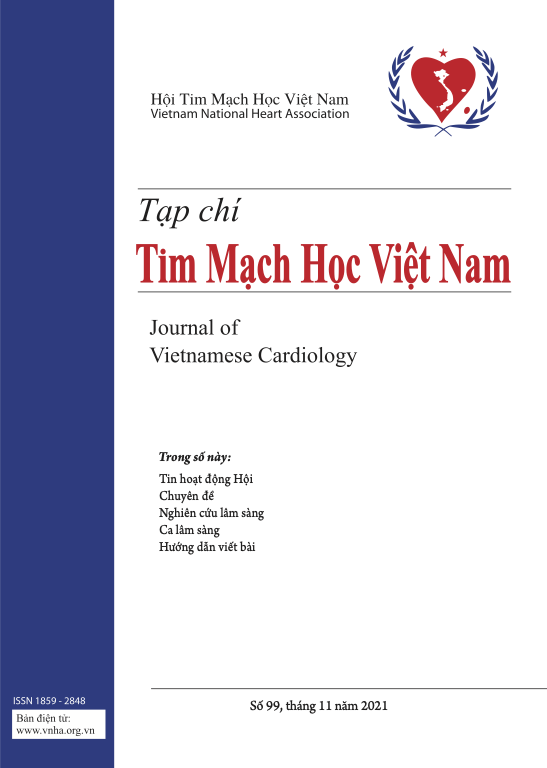Đánh giá kết quả sớm can thiệp nội mạch điều trị bệnh động mạch chi dưới mạn tính ở Viện Tim mạch Việt Nam
Tóm tắt
Mục tiêu: Đánh giá hiệu quả và tính an toàn của can thiệp nội mạch trong điều trị bệnh nhân bệnh động mạch chi dưới có triệu chứng lâm sàng.
Đối tượng và phương pháp: Từ tháng 1.2015 tới tháng 6.2016, chúng tôi thống kê 121 ca can thiệp tổn thương động mạch chi dưới được tiến hành tại Viện Tim mạch Việt Nam, đa số là các tổn thương phức tạp tầng chậu đùi, TASC C (37%) và TASC D (48%).
Kết quả: Thủ thuật thành công trong 114 trường hợp (tỉ lệ thành công 94%). 86% số ca được đặt Stent, chỉ có 14% nong bóng đơn thuần. Các biến chứng chính của thủ thuật bao gồm nhồi máu cơ tim (1%), huyết khối gây tắc lại Stent (1%), suy thận tiến triển (1%), chảy máu cần phải truyền máu (6%).
Kết luận: Can thiệp nội mạch là một biện pháp hiệu quả và an toàn để điều trị các tổn thương động mạch chi dưới.
Tài liệu tham khảo
1. Nguyễn Lân Việt, Nghiên cứu mô hình bệnh tật ở bệnh nhân điều trị nội trú tại Viện Tim mạch Việt Nam trong thời gian 2003-2007. Tạp chí Tim mạch học Việt Nam, 2010. 52: p. 11-17.
![]()
2. Rooke, T.W., et al., 2011 ACCF/AHA focused update of the guideline for the management of patients with peripheral artery disease (updating the 2005 guideline): a report of the American College of Cardiology Foundation/American Heart Association Task Force on Practice Guidelines: developed in collaboration with the Society for Cardiovascular Angiography and Interventions, Society of Interventional Radiology, Society for Vascular Medicine, and Society for Vascular Surgery. Catheter Cardiovasc Interv, 2012. 79(4): p. 501-31.
![]()
3. Norgren, L., et al., Inter-Society Consensus for the Management of Peripheral Arterial Disease (TASC II). J Vasc Surg, 2007. 45 Suppl S: p. S5-67.
![]()
4. Ko, Y.G., et al., Improved technical success and midterm patency with subintimal angioplasty compared to intraluminal angioplasty in long femoropopliteal occlusions. J Endovasc Ther, 2007. 14(3): p. 374-81.
![]()
5. Spinosa, D.J., et al., Simultaneous antegrade and retrograde access for subintimal recanalization of peripheral arterial occlusion. J Vasc Interv Radiol, 2003. 14(11): p. 1449-54.
![]()
6. Trần Huyền Trang, Đánh giá kết quả sớm can thiệp qua da trong điều trị bệnh động mạch chi dưới mạn tính giai đoạn thiếu máu chi trầm trọng 2014, Trường Đại Học Y Hà Nội
![]()
7. Đào Danh Vĩnh, Kết quả ban đầu casn thiệp nội mạch điều trị hẹp tắc mạn tính động mạch chậu, Tạp chí Điện quang 2013. 14(10).
![]()
8. Diehm, C., et al., Mortality and vascular morbidity in older adults with asymptomatic versus symptomatic peripheral artery disease. Circulation, 2009. 120(21): p. 2053-61.
![]()
9. Hirsch, A.T., et al., Peripheral arterial disease detection, awareness, and treatment in primary care.
![]()
JAMA, 2001. 286(11): p. 1317-24.
![]()
10. Diehm, C., et al., High prevalence of peripheral arterial disease and co-morbidity in 6880 primary care patients: cross-sectional study. Atherosclerosis, 2004. 172(1): p. 95-105.
![]()
11. Zhang, H.P., et al., [Recanalization of superficial femoral artery occlusions with Outback LTD catheter]. Zhonghua Wai Ke Za Zhi, 2012. 50(3): p. 226-9.
![]()
12. Schmidt, A., et al., Retrograde recanalization technique for use after failed antegrade angioplasty in chronic femoral artery occlusions. J Endovasc Ther, 2012. 19(1): p. 23-9.
![]()
13. Pappy, R., T.A. Hennebry, and M.S. Abu-Fadel, Retrograde access via the popliteal artery to facilitate the re-entry technique for recalcitrant superficial femoral artery chronic total occlusions. Catheter Cardiovasc Interv, 2011. 78(4): p. 625-31.
![]()
14. Shi, W., et al., Combined antegrade femoral artery and retrograde popliteal artery recanalization for chronic occlusions of the superficial femoral artery. J Vasc Interv Radiol, 2014. 25(9): p. 1363-8.
![]()
15. Tokuda, T., et al., A sheathless retrograde approach via the popliteal artery is useful and safe for treating chronic total occlusions in the superficial femoral artery. J Endovasc Ther, 2014. 21(2): p. 289-95.
![]()
16. Soga, Y., et al., Contemporary outcomes after endovascular treatment for aorto-iliac artery disease.
![]()
Circ J, 2012. 76(11): p. 2697-704.
![]()
17. Soga, Y., et al., Initial and 3-year results after subintimal versus intraluminal approach for long femoropopliteal occlusion treated with a self-expandable nitinol Stent. J Vasc Surg, 2013. 58(6): p. 1547-55.
![]()
18. Krankenberg, H., et al., Nitinol Stent implantation versus percutaneous transluminal angioplasty in superficial femoral artery lesions up to 10 cm in length: the femoral artery Stenting trial (FAST). Circulation, 2007. 116(3): p. 285-92.
![]()
19. Laird, J.R., et al., Nitinol Stent implantation versus balloon angioplasty for lesions in the superficial femoral artery and proXimal popliteal artery: twelve-month results from the RESILIENT randomized trial. Circ Cardiovasc Interv, 2010. 3(3): p. 267-76.
![]()
Schillinger, M., et al., Balloon angioplasty versus implantation of nitinol Stents in the superficial femoral artery. N Engl J Med, 2006. 354(18): p. 1879-88.
![]()
21. Swee, W. et al., Managing Perforations of the Superficial Femoral Artery. Endovascular today, 2014. 10.
![]()








